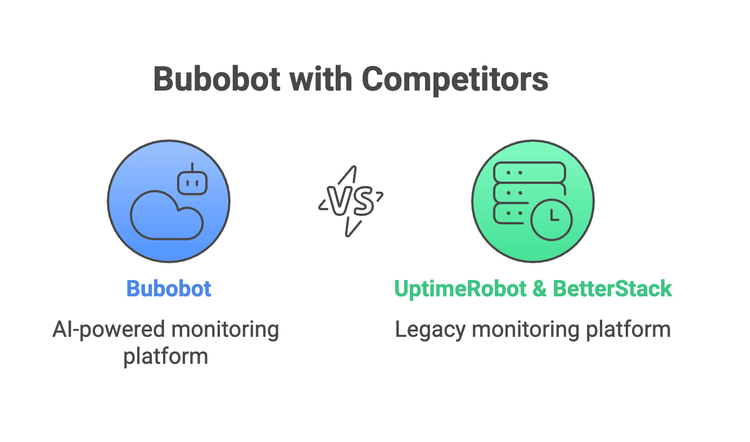Compare Bubobot with Competitors

Choosing the right uptime monitoring solution can make or break your incident response strategy. With so many options available, how do you pick the tool that actually fits your team's needs without burning through your budget?
This guide breaks down the essential criteria for selecting monitoring tools and provides an honest comparison between Bubobot and major competitors like UptimeRobot and BetterStack.
1. Key Criteria for Choosing Monitoring Tools
| Criteria | Why It Matters |
|---|---|
| Monitoring Frequency and Speed of Detection | Fast detection prevents revenue loss during outages. Web uptime monitoring tools with shorter intervals provide better incident response. |
| Setup Complexity | DevOps teams need tools that simplify workflows. The best uptime monitoring software gets you operational quickly without extensive configuration. |
| Pricing Model and Total Cost of Ownership | Per-monitor pricing escalates costs as infrastructure grows. Website uptime monitor solutions with usage-based pricing offer better scalability. |
| Free/Trial Package Limitations | Free uptime monitoring tiers often restrict monitor types, checking intervals, or integration access. |
| Integration | Seamless workflow integration ensures alerts reach the right teams through preferred communication channels. |
| Alerting | Smart monitoring uptime tools reduce alert fatigue while maintaining focus on critical incidents through intelligent filtering. |
| Status page | Some teams need to communicate with 3rd customers for system status by status page. |
2. Bubobot vs UptimeRobot vs BetterStack
| Feature | Bubobot | UptimeRobot | BetterStack |
|---|---|---|---|
| Monitoring Interval | 20 seconds minimum | 30 seconds minimum | 30 seconds minimum |
| Smart Silencing | ✅ Built-in for both static and dynamic contextual rules | ❌ Basic rules only | ✅ Built-in for basic contextual rules |
| AI Anomaly Detection | ✅ AI-powered with retraining | ❌ Not available | ❌ Not available in BetterStack’s uptime product |
| AI Agent Setup | ✅ Chat-based monitor creation | ❌ Manual setup only | ❌ Manual setup only |
| Pricing Model | Usage-based (250k runs free) | Per-monitor ($7-58/month) | Per-monitor ($20-80/month) |
| Integrations | 20+ app, SMS, Calls | 10+ integrations, SMS, Calls | 25+ integrations, SMS, Calls |
| Monitor Types | HTTP, Keywords, Server, Kafka, DNS, Heartbeat | HTTP, Ping, Port, Keyword, Heartbeat | HTTP, Keywords, API, Heartbeat, Playwright |
| Free Tier | Unlimited monitors with total 250,000 runs/month | 50 monitors ❌ Limited with 5-min interval | ❌ Limited with 10 monitors |
| Team Collaboration | ✅ Advanced team features | ❌ Limited team members (max of 5) | ✅ Advanced team features |
| API Access | REST API (Coming soon) | REST API | REST API |
| Status page | Public and private status page with branding | Public status page with branding | Public and private status page with branding |
Speed Advantage Analysis
Bubobot's 20-second intervals beat UptimeRobot's 1-minute and BetterStack's 30-second detection times. That extra 40-second advantage matters during peak traffic or financial transactions when every second of downtime costs money.
AI Capabilities Breakdown
Bubobot's Smart Silencing uses machine learning to reduce alert fatigue—instead of 50 alerts when your API cluster fails, you get relevant notifications that need action. The Bubo AI Agent lets you create monitors through conversation: "Monitor our payment API every 30 seconds." No complex forms required.
Pricing Reality Check
UptimeRobot's per-monitor pricing scales poorly—500 monitors cost significantly more than Bubobot's usage-based approach. BetterStack's premium pricing quickly exceeds budgets. Bubobot's 250,000 free runs typically cover 100-150 monitors checking every minute.
3. Conclusion
Easy Migration from Existing Tools
The Bubo AI Agent can recreate complex setups through conversation, eliminating manual rebuild work.
Cost Savings with Usage-Based Pricing Model
Usage-based pricing offers better flexibility than traditional per-monitor tiers. You don't need to upgrade to an Enterprise package just to access one specific feature. Scale your monitoring naturally without hitting arbitrary plan limits or paying for unused monitor slots.
Improved Incident Detection and Response Times
Reducing detection time from 3 minutes to 20 seconds significantly cuts total downtime duration. Bubobot's anomaly detection adds another layer by identifying performance degradation before complete failures occur, helping prevent incidents entirely.
Key take away: Bubobot's combination of speed, AI capabilities, and flexible pricing provides enterprise-level uptime detector functionality at friendly pricing.